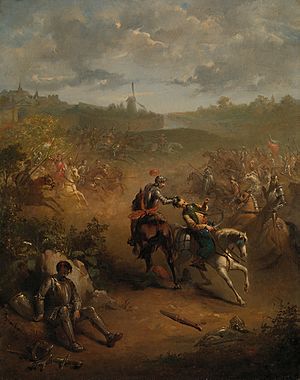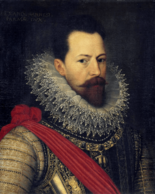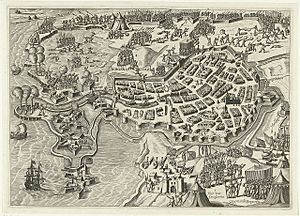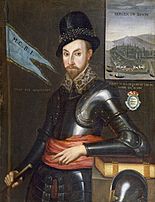Siege of Bergen op Zoom (1588) facts for kids
Quick facts for kids Siege of Bergen-op-Zoom |
|||||||
|---|---|---|---|---|---|---|---|
| Part of the Eighty Years' War & the Anglo–Spanish War | |||||||
 Anno 1588. Marcelis Bax's brave performance during a sortie |
|||||||
|
|||||||
| Belligerents | |||||||
| Commanders and leaders | |||||||
| Strength | |||||||
| 5,000 | 20,000 | ||||||
| Casualties and losses | |||||||
| Low | 1,000 | ||||||
The Siege of Bergen op Zoom was a battle that happened during the Eighty Years' War and the Anglo–Spanish War. It took place from September 23 to November 13, 1588. This siege happened right after the Spanish Armada failed. The famous Spanish commander, Duke of Parma, tried to capture Bergen op Zoom. He used his soldiers who had been ready to invade England.
Bergen op Zoom was defended by English and Dutch forces. Their leaders were Thomas Morgan and Peregrine Bertie. During the siege, an English officer named Grimstone set a clever trap. He pretended to be a Catholic who was unhappy with the English. This led to a big Spanish attack that was stopped with many losses. Soon after, an Anglo-Dutch relief army arrived. This army was led by Maurice of Orange. They forced the Duke of Parma to leave, ending the siege.
Contents
Why the Siege Happened
England was safe after the Spanish armada failed in the summer of 1588. At the same time, the Duke of Parma had a large army ready for the invasion. With the invasion called off, Parma decided to use his army elsewhere.
Parma marched his troops through Brabant. His goal was to capture Bergen op Zoom before winter. He sent some of his troops ahead to try and take the island of Tholen. Tholen had an important town of the same name. It was north of Bergen op Zoom, across the Scheldt river.
The governor of Bergen op Zoom was Thomas Morgan. Most of the soldiers defending the town were English. They were led by Peregrine Bertie, also known as Lord Willoughby, and Sir William Drury. Morgan had been in England helping with the defense against the Armada. Lord Willoughby was in charge while Morgan was away.
Willoughby worked hard to make Bergen op Zoom ready for a fight. He built defenses outside the Wouw Gate. These helped protect the drawbridges and soldiers leaving the town. He also got advice from Count Everard Solms. Solms came from Tholen, where he led a Zeeland regiment.

The Spanish forces advanced through Tholen and attacked the town. But Solms and his Zeeland troops fought them off strongly. The Spanish lost almost 400 soldiers. Their commanders barely escaped drowning as the river waters suddenly rose. Despite this defeat, Parma quickly moved on to Bergen op Zoom.
The Siege Begins
Morgan returned from England to find Parma's army surrounding the town. But Willoughby had already taken action. The defenders of the city opened the dykes. Water flooded the countryside, making it hard for the Spanish to move. Only a few high spots were left for Parma's troops.
The Spanish army had almost 20,000 soldiers. Morgan ordered his troops to make surprise attacks, called sallies. They also built trenches and ravelins (outer defenses). From September 23, several sallies were successful. They forced the Spanish to run from their positions. The Spanish lost many supplies, prisoners, and equipment. During one of these attacks, a young Francis Vere was wounded in his leg by a pike.
Dutch cavalry, made up of Bergen op Zoom traders Paul and Marcellus Bax, also made a sortie. They rode all the way to Wouw, capturing several Spanish prisoners. On the same day, English troops captured a canal boat from Antwerp. They found 60,000 florins (money) on board. This was a big problem for Parma, as he needed that money to pay his soldiers. Parma could not capture any of the water forts. So, he decided to turn the siege into a blockade. This meant trying to cut off supplies to the town.
The Grimstone Trick
During one of the sallies, a man named Robert Redhead captured two important Spanish prisoners. They were Cosimo d'Alexandrini and Pedro de Lugo, an artillery officer. Redhead was a sutler, someone who sells goods to soldiers. He found the Spanish officers checking the strength of the walls near the North Fort. The North Fort was a strong fortress. It guarded the entrance to Bergen op Zoom from the Scheldt river.
The two Spanish prisoners stayed at the house of William Grimstone. Grimstone was a lieutenant in the garrison. The Spanish offered large bribes to let their army into the North Gate. They hoped this would make capturing Bergen much easier. Lord Willoughby soon found out about this plan. He pretended to agree to it.
As a trick, Grimstone pretended to be a strong Catholic. He also said he supported William Stanley, an English soldier who had switched sides. Grimstone and Redhead secretly left the camp. They carried letters from the two Spanish prisoners to the Duke of Parma. The letters said everything was ready for the Spanish to enter the fort.
On October 6, they met with Parma. Parma made them swear on the Sacrament that they were telling the truth. After they swore, he gave them a large gold chain. He also promised them a lot of money if the plan worked.
Parma chose 100 skilled musketeers for the attack. A larger force of 2,000 men would follow them. This larger group was led by Don Sancho de Leyva. Don Juan de Mendoza, Don Alonzo de Idiaquez, and William Stanley were also with them. Grimstone guided them. Before the Spanish troops left, the two Englishmen (Grimstone and Redhead) were tied up and went with them.
It was a dark, moonless autumn evening with bad weather. The Spanish force set off. They waded through the waters of the Scheldt, which came up to their chests. After a while, they reached the gate they were aiming for. The outer portcullis (a heavy gate) had been lifted. The Spanish soldiers rushed into the town. At that moment, Willoughby cut the ropes holding the portcullis. This trapped the first group of Spanish soldiers inside. Francis Vere led the charge against them. All the trapped Spanish soldiers were killed. Meanwhile, more Spanish soldiers were still coming towards the gate.
The Spanish outside quickly realized they were in a trap. They were furious and refused to give up. They tore down the wooden fences and attacked the defenses fiercely. At the same time, the portcullis was opened wide. The soldiers defending the town launched a strong attack on the Spanish. In the confusion, the two English prisoners, Grimstone and Redhead, managed to escape unharmed.
There was a fierce fight. The Spanish could not get out of the trap. Some were killed near the walls. The rest were quickly pushed back. As they retreated, the Spanish were attacked again from an ambush on the dyke. The remaining soldiers were chased into the water. They were completely defeated. Many were killed or wounded, and several high-ranking officers were captured.
To make things worse, the tide started to come in. Soldiers who had easily waded across the moat were now swept away. About 300 drowned trying to get back to their camp. Parma was shocked and could not believe what had happened. When he saw the survivors returning to their camp, he knew he had to end the siege.
Help Arrives
A relief force led by Maurice of Orange arrived the next day. They brought 600 Scottish and Dutch soldiers to join the town's defenders. The combined force then launched another attack. They drove the Spanish away from their positions. With the new soldiers, the Spanish could no longer hold their ground.
Parma had lost many men, and his supplies were running out. So, he set fire to his camp. On the night of November 12, he retreated in a hurry. The next morning, an English force chased the Spanish rearguard. They captured more prisoners and supplies.
What Happened Next
Parma and his army returned to Brussels in defeat. The siege had lasted six weeks. Lord Willoughby had won an important victory. This was especially good news for Queen Elizabeth I, coming so soon after the Spanish Armada's failure.
The Spanish lost 1,000 men during the siege of Bergen op Zoom. Most of them were killed or drowned in the attack. Including the defeat at Tholen and the Armada campaign, Parma had lost about 10,000 men in total. Many died from fighting or sickness. The English and Dutch losses were small, except for some who got sick. Grimstone and Redhead each received 1,000 florins from the Queen. They also got a yearly payment of 600 florins.
The next year, the Spanish army refused to fight because they weren't paid. The money they needed had been lost with the Armada ships. Also, the English had captured the canal boat from Antwerp with the 60,000 florins. Spain's treasury was empty. They had spent a lot of money protecting their colonies and treasure fleets.
Parma then built forts at Roosendaal, Turnhout, and Kempeu. These forts were meant to stop attacks from the Bergen op Zoom soldiers into Brabant. Count Mansfeld also captured the small town of Wachtendonck in Guelderland. During that siege, the bomb shell was used for the first time. It had been invented recently by a craftsman from Venlo.
Francis Vere showed great bravery during the siege. Lord Willoughby made him a Knight on the battlefield. The next year, Vere would lead the English army in the Netherlands after Willoughby left. He held this command for twenty years. Both Queen Elizabeth and the Dutch government respected him highly.
Bergen op Zoom stayed in English and Dutch hands. It successfully fought off more Spanish sieges and attacks for the next forty years. A notable siege happened in 1622, where English troops again played a big part.
See also
 In Spanish: Asedio de Bergen op Zoom (1588) para niños
In Spanish: Asedio de Bergen op Zoom (1588) para niños




